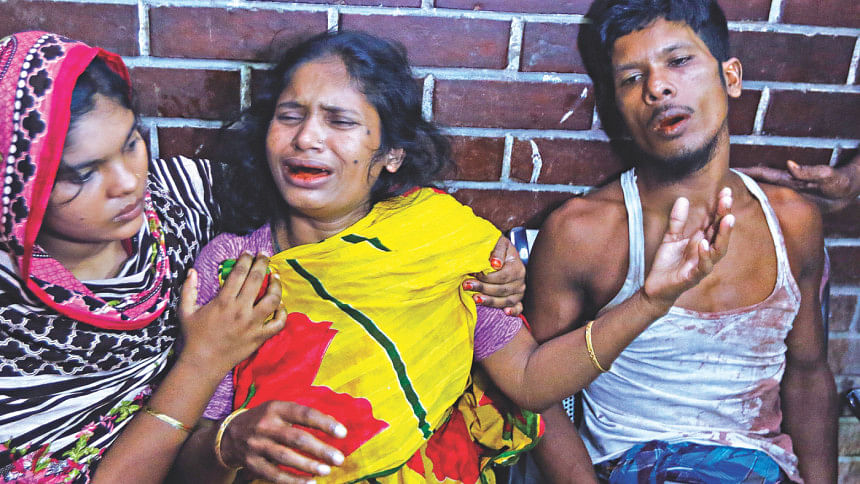Six kids killed in cylinder blast

The colourful balloons attracted children from the shanties of the slum across the street.
About 12 of them holding Tk 5 or Tk 10 notes waited eagerly as a man inflated the balloons using a gas cylinder.
But everything changed in a blink when the cylinder exploded with a loud bang.
Six children died and at least 20 others, mostly children, were seriously injured in the blast on road 11 in the capital’s Rupnagar around 3:30pm yesterday, said Abul Kalam Azad, officer-in-charge of Rupnagar Police Station.
Police and grieving family members could identify the mutilated bodies of Rubel, 11, Ria Moni, 7, Farzana, 6, Ramzan, 10, and Nupur, 7. Officials are yet to identify a boy aged about 8.
“I just heard a loud bang. Then I saw children lying in pools of blood. Some of them were groaning in pain,” said Sharif Mahmud, who was at a nearby shop.
Hossain, a roadside vendor of snacks, told The Daily Star that the explosion happened several minutes after the balloon seller arrived there and started inflating his balloons.
“Smoke engulfed the area for a minute after the blast,” he said.
Police arrested balloon seller Abu Sayeed last night at National Institute of Traumatology & Orthopaedic Rehabilitation, said OC Azad.
He lost part of his left arm and sustained injuries to his stomach, the officer said, adding that they were filing a case against him.
Police and firefighters reached the scene soon afterwards and took the injured to Dhaka Medical College Hospital and Shaheed Suhrawardy Medical College and Hospital.
Doctors at DMCH said the condition of at least five of the children were critical.
A pall of gloom descended on the hospitals where families searched for their children.

“My son’s body has been split in half,” Rubel’s father Nur Hossain, a rickshaw puller, said as he broke down at Suhrawardy hospital.
He was near the scene at the time of the blast.
“My son wanted Tk 5 from me for a balloon. I promised him of giving the money after I returned at night. I began to leave, pulling my rickshaw. I was only yards away when I felt that the very ground had been shaken by the explosion,” Nur said.
Nur’s shirt was smeared with his son’s blood.
Eight-year-old Mariam Rikta narrowly escaped with minor injuries. She was sitting beside the body of her sister Farzana at Suhrawardy hospital, unable to speak.
Farzana had died on the spot.
Mostaq, uncle of another victim Riya, said his niece went there to buy a balloon for her four-year-old brother Mahim.
She died of her injuries at the hospital.
Parents of most of the victims are rickshaw puller, garment worker, domestic help or day labourers.
Thirteen-year-old Biswajit’s mother Jhuma said she didn’t know whether her son would see again as his eyes were damaged by splinters.
She added that she didn’t have the money required for proper treatment of his eyes.
WHAT CAUSED THE TRAGEDY
Firefighters and experts said old and discarded LPG and CNG cylinders are often used to store gas used for inflating balloons.
Samsul Alam, chief inspector of the Department of Explosives, told The Daily Star that balloon sellers often modified the upper part of old and discarded LPG and CNG cylinders and used them.
It is very risky and often results in explosions, he said.
He added that the sellers used a chemical reaction to produce hydrogen inside the cylinder. But they often do not know how to control the production.
“We gave advertisement in newspapers to make people aware of the dangers,” he said.


 For all latest news, follow The Daily Star's Google News channel.
For all latest news, follow The Daily Star's Google News channel. 



Comments